Week 4
Roughages |
 |
 |
Instructions for listening to audio clips
- Download the QuickTime
Player to listen to the audio files.
- Read the QuickTime
Instructions for installation help.
- Download the RealPlayer to listen to the audio files
- Instructions are on the RealPlayer download page
Hay
Text Transcript
Follow along with the audio...
- Hay and silage
- Established forms of nutrient preservation
- Common
- Additional information on hay making
- Additional information on silage making
- Additional information on forages
- Hay
- U.S.
- 2001, more than 156.7 million tons of hay valued at more than
$12.6 billion
- App. 18% of total feeds fed
- Most effective method to store forages
- Production
- Harvested during growing season or periods of excess
- Preserved via curing
- Packaged
- Stored
- Fed during periods of deficits
- Feeding
- Confinement
- Low availability on pasture and range
- Figure 9.1 – Hay fed to cattle on range

- Figure 9.2 – Lambs consuming hay from feeder
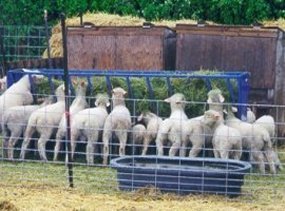
- Primarily to ruminants and nonruminants herbivores
- Ruminants
- Structural CHO, nonstructural CHO, protein, vitamins, and
minerals
- Processed legume hay in swine and poultry rations
- Table 9.1 – Average nutritional value of one legume and one grass
hay on DM basis
Table 9.1 - Average Nutritional Value of One Legume and One Grass
Hay on DM Basis
| |
Feedstuff |
| |
Alfalfa,
hay, early bloom |
Ryegrass,
Italian, hay, early bloom |
| DM, % |
90 |
88 |
| CP, % |
18.0 |
11.4 |
| NDF, % |
42 |
69 |
| ADF, % |
31 |
45 |
| TDN, Beef, % |
60 |
54 |
| NEL, Dairy, Mcal/kg |
1.35 |
1.20 |
| TDN, Sheep, % |
56 |
57 |
| DE, Horses, Mcal/kg |
2.48 |
1.94 |
| Ca, % |
1.41 |
0.62 |
| P, % |
0.22 |
0.34 |
- Storage forms
- Loose, baled, cubed, pelleted, chopped
- Figure 9.3 – Large, round bales
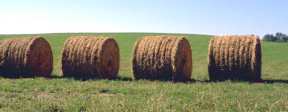
- Figure 9.4 – Small, rectangular bales

- Feeding forms
- Nutrient basis, cost greater for preserved versus fresh forages
- Harvesting equipment and storage facilities
- Yield and nutritional value
- Compromise
- Harvested to optimize
- Managed for subsequent production
- Nutritional value varies
- Factors influencing nutritional value
- Forage species
- Maturity at harvest
- Efficiency of harvesting, curing, packing, storing, and
feeding
- Most important: efficiency of curing
- Curing time
- Curing weather
- High temperature and low moisture
- Use of mechanical conditioning, chemical conditioning,
and/or preserving agents
- Forage species
- Legumes, grasses, and forage grains
- Growing conditions and animal requirements
- Harvesting or cutting
- Figure 9.5 – Swather harvesting grass forage
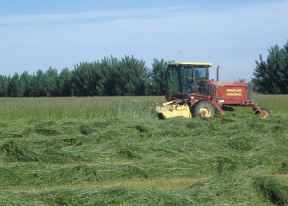
- Timing
- Critical to maximize yield of digestible nutrients per unit
of land
- Alfalfa
- Grasses
- Varies with species
- In general, boot to early head stages
- For grass-legume mixtures
- Maturity for predominant species
- Moisture content
- Time of day
- Evening
- Maximize nonstructural CHO
- Morning
- Curing
- Harvested forage dried prior to baling
- Figure 9.6 – Alfalfa forage curing in windrows in field
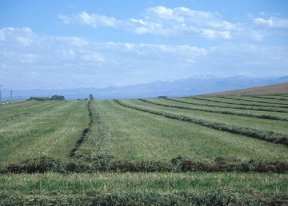
- Improve nutritional value and promote storage
- Raked to facilitate drying
- Packaging and storing
- Baling
- Primary method to package
- Figure 9.7 – Round baler baling in field

- Optimal moisture content 15-18%
- Leaf loss versus storage loss
- Nutrient losses
- Inevitable
- Cutting, curing, packaging, storing, and feeding
- To maximize digestible nutrient yield, minimize losses
- Normal range from 20-40%
- Nonoptimal conditions may exceed 75%
- Respiration
- Continues until moisture level to 40% or less
- Plant enzymes metabolize nutrients
- Primary losses are nonstructural CHO and protein
- Extent influenced by weather conditions during curing
- Dry, hot climates minimize losses
- Oxidation
- Leaching
- Range from 4-15%
- May be as high as 40%
- Primary losses are water soluble proteins, CHO, and vitamins
- Curing weather
- Sunlight
- Vitamin content
- Decrease in A
- Increase in D
- Storage
- Heat damage
- Baled at greater than 20% moisture susceptible
- Process
- Moisture promotes microorganism growth
- Growth generates heat
- Maillard or browning reaction
- Spontaneous combustion may occur at 160-180 degrees
Fahrenheit
- Location and conditions
- Indoors
- Recommended
- General, DM loss is 5-10%
- Outdoors
- Extent by weather conditions and type of hay
- Optimal: cool and dry
- Primary losses are nonstructural CHO
- Provided appropriately cut, cured, packed, and stored, stored
for years with minimal losses
- Most effective long-term method to store forages
- Mechanical
- Cutting
- Incomplete forage recovery
- Cured, packed, stored, and fed, losses occur
- Primary components lost are leaves
- For legumes
- For grasses
- Nutritional value of leaves greater than stems
- Extent influenced by plant material moisture and equipment
- To minimize, manage handling time, frequency, and equipment
- Maturity at harvest
- Significant impact on nutritional value
- Optimal time
- Maximize yield of digestible nutrients per unit of land
- Consider GI tract and nutrient requirements of animal
- Ruminants
- Increase in structural CHO
- Decrease in digestion rate, passage rate, and
forage intake
- Net effect: decrease in nutrient intake and
potential to limit production
- Horses
- Increase passage rate and partially compensate for
lower quality
- Advancing maturity
- Yield increases
- Protein and nonstructural carbohydrate contents decrease
- Structural carbohydrate content increases
- Nutrient digestibilities decrease
- Decrease in ratio of leaves to stems
- Leaves versus stems
- Leaves have higher nutrient content and digestibility
- Increase in cellulose and lignin of stems
- Relationship between forage yield and nutritional value significant
in trading hay
- Relative feed value (RFV)
- System to account for nutritional value of hay
- Factor in determining value per unit of mass
- Does not account for protein quantity or quality
- No units
- Calculated on range of forages
- Compare similar forages
- Equations:
- % DDM = (88.9 – (% ADF x 0.779))
- % DMI = (120 / % NDF)
- RFV – (% DDM x % DMI) / 1.29
- Table 7-17 on page 140 of text – Relative feeding value
of various forages
- Assessment of nutritional value
- Focus on points specific to hay
- Estimate
- Objective and subjective methods
- In general, bought and sold on analytical methods
- In U.S., National Forage Testing Association
- Administers voluntary lab certification
- To standardize testing of forages
- Initial analysis is sensory analysis
- Primarily visual
- Relative number of buds, blossoms, and seed heads
- Relative amounts of leaves to stems and size of stems
- Color
- Bright and no dark forage
- Presence of foreign materials
- Olfactory
- Unfavorable odor
- Reduce nutritional value, reduce palatability, and
may cause toxicity
- Laboratory analysis
- Representative sample
- Vary by feedstuff
- For hay, sample for lot
- Lot is hay from the same cutting, similar field,
same stage of maturity, and same species and variety
- Use of sampling tube or probe
- Collect 20 random samples per lot
- Figure 9.8 – Use of probe
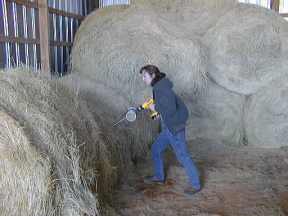
- Store and ship sample in airtight container
- Proximate analysis
- DM
- CP
- Positively correlated with quality
- Value hay
- Ash
- Detergent fiber system
- Energy
- Near infrared (NIR) analysis
- Quick, inexpensive, computerized
- Chemical components
- Procedure
- Sample ground and dried
- Placed in spectrophotometer
- Exposed to NIR
- Radiation reflected and converted to electrical
energy
- Measured and measurement transferred to computer
- Compares value to wet-chemistry derived database
of similar feed sample
- As accurate as database
|
 |
 |
|








